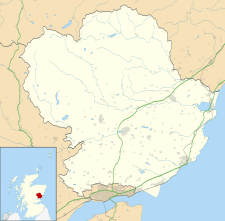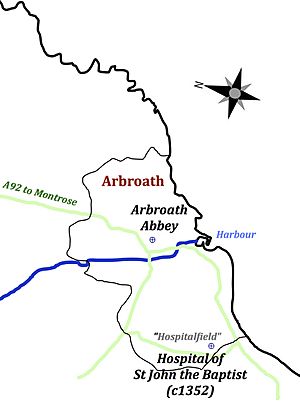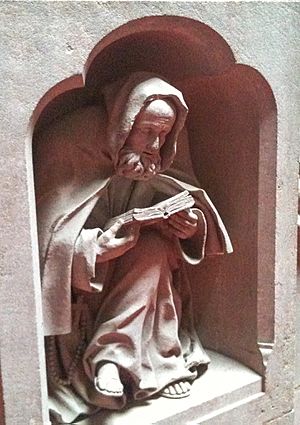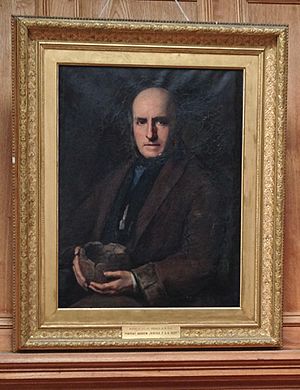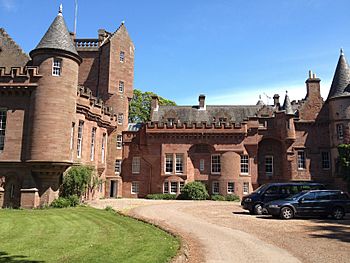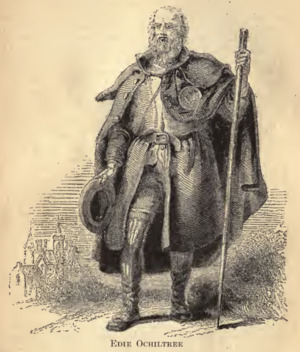Hospital of St John the Baptist, Arbroath facts for kids
Quick facts for kids Hospital of St John the Baptist |
|
|---|---|
| Arbroath Abbey | |

Fragment of what may be the medieval doorway located within Hospitalfield House
|
|
| Geography | |
| Location | Arbroath, Angus, Scotland |
| Coordinates | 56°33′16″N 2°36′39″W / 56.5545°N 2.6107°W |
| Organisation | |
| Care system | Medieval Sub-Monastic care |
| Hospital type | Medieval Abbey Hospital |
| Patron | Archbishop David Beaton during 1539-1546 |
| History | |
| Founded | c. 1325 |
| Closed | c. 1560 |
| Demolished | After 1560 |
The Hospital of St John the Baptist was a special kind of hospital in Arbroath, Scotland. It was built a long time ago, in the early 1300s. The hospital was started by the monks from Arbroath Abbey, which was a large monastery nearby. We don't know the exact date it began, but it was first written about in 1325. At that time, Bernard of Kilwinning was the head monk, called the Abbot, of Arbroath Abbey.
Arbroath Abbey itself was founded even earlier, in 1178, by William the Lion, who was the King of Scotland. It was built for a group of Benedictine monks. The hospital might have been used by people traveling, or as a place for prayers, or even as a home for the poor.
Today, you can still see a small part of the old hospital. It's a piece of a doorway that was built into a house called Hospitalfield House. In the 1800s, about 120 skeletons were found near Hospitalfield House. This suggests there was a burial ground there in medieval times. Hospitalfield House is now an arts center. It also inspired a fictional house in a famous book called The Antiquary by Sir Walter Scott.
Contents
A Look Back: The Hospital's Story
The full story of the Hospital of St John the Baptist, which was "near Arbroath," isn't completely clear. A historian named Miller wrote about it in 1860. He said the hospital's chapel was close to Hospitalfield House. It was part of the Abbey's hospital or infirmary. This spot was chosen because it was healthy and far enough away from the main monastery. This helped prevent the spread of diseases.
Miller also wrote that the hospital existed before 1325. In that year, Abbot Bernard leased some land called "Spedalfeilde" that belonged to the hospital. He rented it out for five years. The people who leased the land had to build two farmhouses. This shows how the Abbey was managing its lands wisely.
The hospital was connected to the "Eleemosynary of Arbroath." This means it was a charitable place that helped people. In 1464, a group of people looked into the hospital's foundations. They said that "Spitalfelde" and its chapel were part of the monastery's property. The monks received money from these lands each year. The chapel was officially dedicated on August 23, 1485, by the Bishop of Dromore. The last time the chapel was mentioned in the Abbey's records was in 1490. It said the chapel needed repairs because it was in danger of falling apart.
In 1543, a document describing the hospital's lands was created. This document is still kept by the people who manage Hospitalfield House today. Later, in the 1570s, Alexander Beaton, whose father was a very important church leader, lived at Hospitalfield.
Finding Clues: Archaeology in the 1800s
David Miller, the historian, described Hospitalfield House in 1860. He believed that the oldest part of the house was actually part of the ancient Abbey hospital. He noticed old doors and other signs in the walls. One side of an old door was found during renovations. The owner, Patrick Allan-Fraser, wisely decided to keep it visible. This door seemed to be a main entrance to the hospital. Its style suggested the hospital was built 50 to 100 years after the Abbey.
In late 1860, Patrick Allan-Fraser made an exciting discovery. While a field was being plowed, human bones were found. Mr. Fraser stopped the work to investigate further. He found parts of several skeletons. In 1861, an expert named Andrew Jervise led an excavation. They found about 120 skeletons in shallow graves. These were likely from a burial ground next to the hospital.
Jervise wrote about the discovery in detail. He explained that the skeletons were found in rows. Most of them were very complete, and their teeth looked healthy. The bodies were laid out straight. Most heads pointed southwest, except for some children's remains. Jervise concluded that this was the cemetery for the Hospital of St John the Baptist. He was sure the hospital had stood nearby.
During the same digs, some building foundations were found. Jervise wasn't completely sure if they were from the hospital chapel. However, he knew the chapel was recorded as being in this area. More recently, in the 1980s, more foundations were found when the house's courtyard was redone. Human remains have also been found at a nearby caravan park in 1952 and 1996.
What's Left of the Hospital Today
The only part of the original hospital buildings you can still see is a piece of a doorway. It's built into a room inside Hospitalfield House. You can find this old doorway fragment inside the house, near one of the bay windows. The picture in the infobox at the top of this article shows it.
Hospitalfield House: A New Purpose
The remains of the old hospital are found in and around Hospitalfield House. After the Scottish Reformation, a man named James Fraser bought the land around 1665. The house you see today was built in the 1800s. It was the home of Patrick Allan Fraser, a famous Scottish painter and collector of old things.
After Patrick Allan Fraser died, the house was given to a trust. This trust helps train people in the arts. Today, Hospitalfield House is still run as a charity arts center. It is considered a very important historic building in Scotland.
Sir Walter Scott and The Antiquary
Sir Walter Scott was a very famous Scottish writer. He published his third novel, The Antiquary, in 1816. Part of the story takes place around Arbroath, which Scott called "Fairport" in his book. Scott had visited Hospitalfield House in 1803 and again in 1809. He used it as the inspiration for "Monkbarns," the fictional house of the main character, Jonathan Oldbuck.


